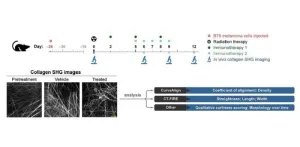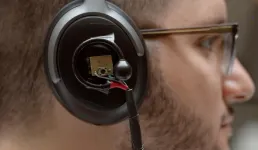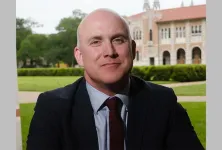(Press-News.org) A groundbreaking study led by UCLA Health has unveiled the most detailed view of the complex biological mechanisms underlying autism, showing the first link between genetic risk of the disorder to observed cellular and genetic activity across different layers of the brain.
The study is part of the second package of studies from the National Institutes of Health consortium, PsychENCODE. Launched in 2015, the initiative, chaired by UCLA neurogeneticist Dr. Daniel Geschwind, is working to create maps of gene regulation across different regions of the brain and different stages of brain development. The consortium aims to bridge the gap between studies on the genetic risk for various psychiatric disorders and the potential causal mechanisms at the molecular level.
“This collection of manuscripts from PsychENCODE, both individually and as a package, provides an unprecedented resource for understanding the relationship of disease risk to genetic mechanisms in the brain,” Geschwind said.
Geschwind’s study on autism, one of nine published in the May 24 issue of Science, builds on decades of his group’s research profiling the genes that increase the susceptibility to autism spectrum disorder and defining the convergent molecular changes observed in the brains of individuals with autism. However, what drives these molecular changes and how they relate to genetic susceptibility in this complex condition at the cellular and circuit level are not well understood.
Gene profiling for autism spectrum disorder, with a few exceptions in smaller studies, has long been limited to using bulk tissue from brains from autistic individuals after death. These tissue studies are unable to provide detailed information such as the differences in brain layer, circuit level and cell type-specific pathways associated with autism as well as mechanisms for gene regulation.
To address this, Geschwind used advances in single-cell assays, a technique that makes it possible to extract and identify the genetic information in the nuclei of individual cells. This technique provides researchers the ability to navigate the brain’s complex network of different cell types.
More than 800,000 nuclei were isolated from post-mortem brain tissue of 66 individuals from ages 2 to 60, including 33 individuals with autism spectrum disorder and 30 neurotypical individuals who acted as controls. The individuals with autism included five with a defined genetic form called 15q duplication syndrome. Each sample was matched by age, sex, and cause of death balanced across cases and controls.
Through this, Geschwind and his team were able to identify the major cortical cell types affected in autism spectrum disorder, which included both neurons and their support cells, known as glial cells. In particular, the study found the most profound changes in the neurons that connect the two hemispheres and provide long range connectivity between different brain regions and a group of interneurons, called somatostatin interneurons that are important for maturation and refinement of brain circuits.
A critical aspect of this study was the identification of specific transcription factor networks – the web of interactions whereby proteins control when a gene is expressed or inhibited – that drive these changes that were observed. Remarkably, these drivers were enriched in known high-confidence autism spectrum disorder risk genes and influenced large changes in differential expression across specific cell subtypes. This is the first time that a potential mechanism connects changes occurring in brain in ASD directly to the underlying genetic causes.
Identifying these complex molecular mechanisms underlying autism and other psychiatric disorders studied could work to develop new therapeutics to treat these disorders.
“These findings provide a robust and refined framework for understanding the molecular changes that occur in brains in people with ASD -- which cell types they occur in and how they relate to brain circuits,” Geschwind said. “They suggest that the changes observed are downstream of known genetic causes of autism, providing insight into potential causal mechanisms of the disease.”
Article: Molecular cascades and cell type–specific signatures in ASD revealed by single-cell genomics, Published May 24, 2024, Wamsley et al., Science, 2024, http://www.science.org/doi/10.1126/science.adh2602
END
Groundbreaking study connects genetic risk for autism to changes observed in the brain
UCLA Health study part of massive brain, genetic mapping initiative
2024-05-24
ELSE PRESS RELEASES FROM THIS DATE:
NFL’s Buffalo Bills continue CPR education kicking off year 2 of the HeartBEAT initiative
2024-05-23
DALLAS, May 23, 2024 —According to American Heart Association data, 9 out of every 10 people who experience cardiac arrest outside of a hospital die. This is in part because they do not receive immediate cardiopulmonary resuscitation (CPR) more than half of the time. CPR, especially if performed immediately, can double or triple a person’s chance of survival. The American Heart Association and the Buffalo Bills want more people to be confident and capable when faced with a cardiac emergency. Through the HeartBEAT ...
Renewable grid: Recovering electricity from heat storage hits 44% efficiency
2024-05-23
Images
Closing in on the theoretical maximum efficiency, devices for turning heat into electricity are edging closer to being practical for use on the grid, according to University of Michigan research.
Heat batteries could store intermittent renewable energy during peak production hours, relying on a thermal version of solar cells to convert it into electricity later.
"As we include higher fractions of renewables on the grid to reach decarbonization goals, we need lower costs and longer durations of ...
Galaxies actively forming in early universe caught feeding on cold gas
2024-05-23
Researchers analyzing data from NASA’s James Webb Space Telescope have pinpointed three galaxies that may be actively forming when the universe was only 400 to 600 million years old. Webb’s data shows these galaxies are surrounded by gas that the researchers suspect to be almost purely hydrogen and helium, the earliest elements to exist in the cosmos. Webb’s instruments are so sensitive that they were able to detect an unusual amount of dense gas surrounding these galaxies. This gas will likely end up fueling the formation of new stars in the galaxies.
“These ...
Developing novel methods to detect antibiotics in vegetables and earthworms
2024-05-23
“The massive use of antibiotics and antimicrobials in people and animals has led to these substances appearing in unexpected environmental samples,” said Irantzu Vergara, researcher in the UPV/EHU’s IBeA group. Drugs that do not end up fully metabolised in the body reach the environment through various routes (such as manure, sewage sludge used as fertilisers, etc.), are leached into the soil and may end up transferring to crops or earthworms, which are at the base of the food chain. “Although ...
New biomarkers of response in melanoma immunotherapy
2024-05-23
Collagen, a major component of the extracellular matrix, plays a crucial role in tumor development. During the development of tumors (“tumorigenesis”), collagen fibers become linearized and densely deposited, hindering immune cell infiltration and promoting tumor metastasis. However, quantifying these collagen changes during melanoma progression has been challenging.
In-vivo imaging of collagen
As reported in Biophotonics Discovery, researchers from the Morgridge Institute for Research and University of Wisconsin – Madison recently addressed this challenge by using quantitative imaging to visualize collagen ...
AI headphones let wearer listen to a single person in a crowd, by looking at them just once
2024-05-23
Noise-canceling headphones have gotten very good at creating an auditory blank slate. But allowing certain sounds from a wearer’s environment through the erasure still challenges researchers. The latest edition of Apple’s AirPods Pro, for instance, automatically adjusts sound levels for wearers — sensing when they’re in conversation, for instance — but the user has little control over whom to listen to or when this happens.
A University of Washington team has developed an artificial intelligence system that lets a ...
Electromechanical material doesn’t get ‘clamped’ down
2024-05-23
HOUSTON – (May 23, 2024) – Lighting a gas grill, getting an ultrasound, using an ultrasonic toothbrush ⎯ these actions involve the use of materials that can translate an electric voltage into a change in shape and vice versa.
Known as piezoelectricity, the ability to trade between mechanical stress and electric charge can be harnessed widely in capacitors, actuators, transducers and sensors like accelerometers and gyroscopes for next-generation electronics. However, integrating these materials into miniaturized systems has been difficult ...
Most young women treated for breast cancer can have children, study shows
2024-05-23
In a study of nearly 200 young women who have survived breast cancer, most of those who tried to conceive were able to become pregnant and give birth
This study fills in major gaps from previous studies of fertility among breast cancer survivors
BOSTON – New research by Dana-Farber Cancer Institute investigators has encouraging news for young women who have survived breast cancer and want to have children.
The study, which tracked nearly 200 young women treated for breast cancer, found that the majority of those who tried to conceive during a median of 11 years after treatment were able to become pregnant and give birth to a child.
The findings, ...
SWOG researchers will present key results at ASCO 2024
2024-05-23
Researchers from SWOG Cancer Research Network, a cancer clinical trials group funded by the National Cancer Institute (NCI), part of the National Institutes of Health (NIH), will share results of their work in 30 presentations at the 2024 American Society of Clinical Oncology (ASCO) Annual Meeting, which takes place May 31 – June 4 in Chicago.
The clinical trials reported on in this work are led by SWOG and conducted by the NIH-funded NCI National Clinical Trials Network (NCTN) and the NCI Community Oncology Research ...
MD Anderson Research Highlights: ASCO 2024 Special Edition
2024-05-23
ABSTRACTS: 2018, 2517, 3513, 5504, 6016, 7007, 9515, 12017, LBA8007, LBA9516
CHICAGO ― The University of Texas MD Anderson Cancer Center’s Research Highlights showcases the latest breakthroughs in cancer care, research and prevention. These advances are made possible through seamless collaboration between MD Anderson’s world-leading clinicians and scientists, bringing discoveries from the lab to the clinic and back.
This special edition features presentations by MD Anderson researchers at the 2024 American Society of Clinical Oncology (ASCO) Annual Meeting. In addition to the ...
LAST 30 PRESS RELEASES:
Making lighter work of calculating fluid and heat flow
Normalizing blood sugar can halve heart attack risk
Lowering blood sugar cuts heart attack risk in people with prediabetes
Study links genetic variants to risk of blinding eye disease in premature infants
Non-opioid ‘pain sponge’ therapy halts cartilage degeneration and relieves chronic pain
AI can pick up cultural values by mimicking how kids learn
China’s ecological redlines offer fast track to 30 x 30 global conservation goal
Invisible indoor threats: emerging household contaminants and their growing risks to human health
Adding antibody treatment to chemo boosts outcomes for children with rare cancer
Germline pathogenic variants among women without a history of breast cancer
Tanning beds triple melanoma risk, potentially causing broad DNA damage
Unique bond identified as key to viral infection speed
Indoor tanning makes youthful skin much older on a genetic level
Mouse model sheds new light on the causes and potential solutions to human GI problems linked to muscular dystrophy
The Journal of Nuclear Medicine ahead-of-print tip sheet: December 12, 2025
Smarter tools for peering into the microscopic world
Applications open for funding to conduct research in the Kinsey Institute archives
Global measure underestimates the severity of food insecurity
Child survivors of critical illness are missing out on timely follow up care
Risk-based vs annual breast cancer screening / the WISDOM randomized clinical trial
University of Toronto launches Electric Vehicle Innovation Ontario to accelerate advanced EV technologies and build Canada’s innovation advantage
Early relapse predicts poor outcomes in aggressive blood cancer
American College of Lifestyle Medicine applauds two CMS models aligned with lifestyle medicine practice and reimbursement
Clinical trial finds cannabis use not a barrier to quitting nicotine vaping
Supplemental nutrition assistance program policies and food insecurity
Switching immune cells to “night mode” could limit damage after a heart attack, study suggests
URI-based Global RIghts Project report spotlights continued troubling trends in worldwide inhumane treatment
Neutrophils are less aggressive at night, explaining why nighttime heart attacks cause less damage than daytime events
Menopausal hormone therapy may not pose breast cancer risk for women with BRCA mutations
Mobile health tool may improve quality of life for adolescent and young adult breast cancer survivors
[Press-News.org] Groundbreaking study connects genetic risk for autism to changes observed in the brainUCLA Health study part of massive brain, genetic mapping initiative




